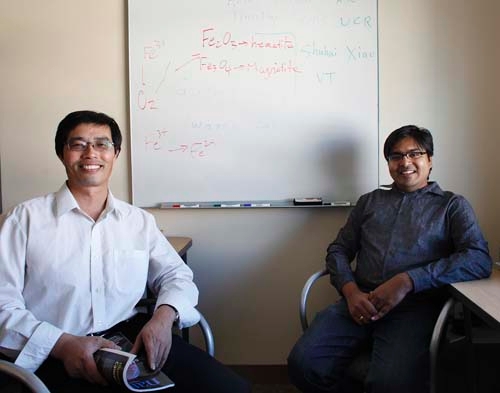UNLV scientists help find possible key to growth of animal life

There are questions to which the answers will always remain elusive.
But don’t tell that to these two scientists at UNLV.
Ganqing Jiang and Swapan Sahoo are geologists. Jiang is a professor in the geoscience department, and Sahoo is working on his doctorate degree.
They and some colleagues at universities in Arizona and California set out a few years ago to answer one of the most basic questions in their field: Why did animals suddenly appear on Earth 600 million years ago?
Before that, the oceans were nearly oxygen-free, and the planet was pretty much just dirt, water and icky little microbes. Nothing fun to look at.
But afterward? That’s when the explosion of life really began. Simple animals begat arthropods, which led to complex animals, and so on.
Next thing you know, you’ve got plants and amphibians and birds and flowers and giant dinosaurs and tiny vampire bats and even those funny looking squirrels that fly from tree to tree by turning their floppy armpit hair into wings.
“What caused this change?” Jiang said he wondered. “What kind of chemical conditions, or climate conditions, could allow primitive animals to live?”
Scientists had already posed two basic explanations.
First, because animals need oxygen, some scientists thought there had to be some sort of oxygen explosion right before the animals appeared. A whole bunch of oxygen suddenly showing up and, voila, animals.
Problem was, no one ever found convincing evidence for such an event. Clearly, something had happened, though. The air we breathe is 20 percent oxygen today. It had to come from somewhere.
Some other folks figured the sudden appearance of animals was just another phase in the evolution of life on Earth. Ho-hum, time moves forward. The only constant is change. And so on.
Jiang, Sahoo and their colleagues – working with a $500,000 National Science Foundation grant – appear to have figured it out.
In a paper published last month in the journal Nature, the research team said they found evidence there was an “oxygenation event” just before the rise of animals. Sahoo was the paper’s lead author, while Jiang was the lead investigator.
There are some seriously complicated scientific methods involved here, but they explained the basics:
There are a few places in the world where scientists have already found a bunch of rocks about 600 million years old. Most rocks from that time don’t exist anymore because they’ve been incorporated back into the Earth’s crust.
One of the places where they do exist is in south China, which Jiang happens to be familiar with. He’s from that country, and he’s been working on this and related questions for the last 15 years.
South China also makes a nice place to dig because there’s so much construction going on in the booming country that a lot of it is freshly dug up for projects such as roads.
So a couple summers ago, the team traveled there and dug up a whole bunch of really old rocks and stored them in a drawer at the University of Nevada, Las Vegas. They’re almost entirely black because they’re made up of mostly organic material – stuff that used to be alive.
But oxygen doesn’t leave fossils, so they had to look for things that are present when oxygen is present.
The researchers shaved off tiny pieces of these rocks, and a fancy machine told them what was inside. That matters because if the rocks were formed in an environment free of oxygen, they’d have certain properties, while if they were formed in an oxygen-rich environment, they’d have other properties.
Guess what?
Yup. Oxygen-related properties.
Jiang called the evidence “unambiguous fingerprints” of oxygen.
It turns out, all of this coincided with the end of the iciest ice age in the history of ever. The whole planet was pretty much covered in ice, earning it the nickname “Snowball Earth.”
All of this – the end of the snowball period, the increase in oxygen content and the proliferation of animal life – are probably related. With less ice, more life flourished, which meant more nutrients, which could have led to more oxygen, which would lead to more life.
The task now is for researchers around the world to dig up more 600-million-year-old rocks from other places to see if they show the same evidence of climate change that makes what’s going on today look like a minor heat wave.
And then, they’ll figure out if this same model could be applied elsewhere, say on another planet in another solar system.
Who knows? Maybe there are answers to those questions.
Contact reporter Richard Lake at rlake@reviewjournal.com or 702-383-0307.